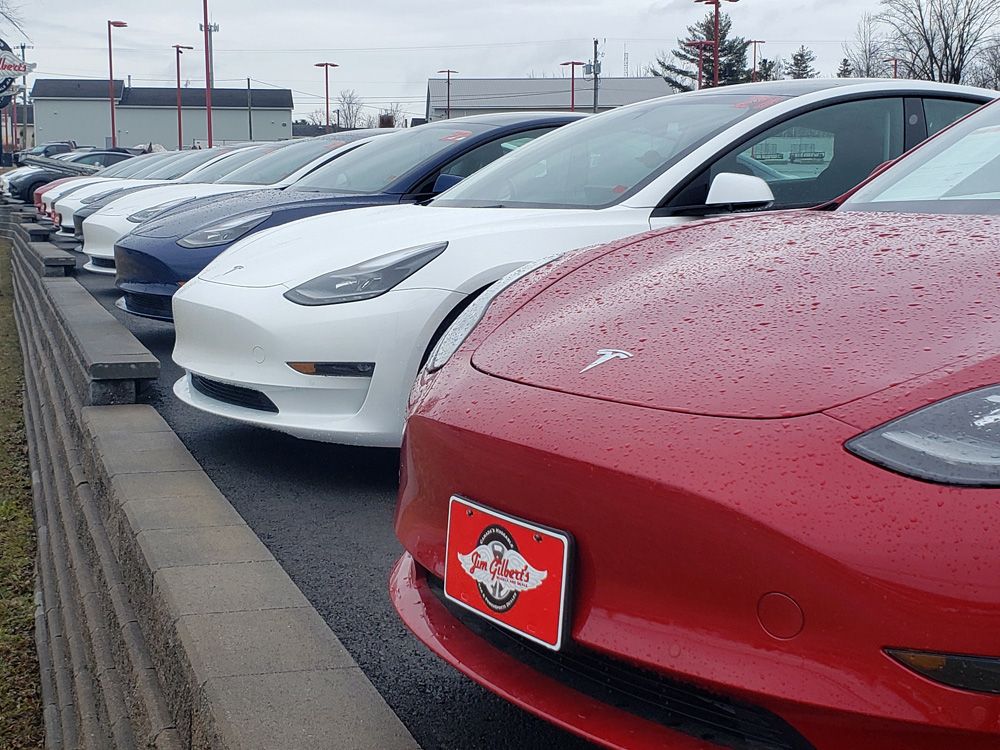deleted by creator
Can confirm, I haven’t even thought about buying an EV since I bought an EV.
“Where’s my goddamn affordable electric car, Bruce?”
Truly “poor people” (to use your words) typically don’t buy a lot of new cars in the first place. People on the lower end of the income scale are the main drivers of the used vehicle market.
Incentivizing EV purchases and infrastructure ultimately helps everyone. It will bring efficiencies to the supply chain, and will drive investment into resources that should help drive prices down. At the same time, within the next 5 years or so you should see growth in the used EV market, which as more stock becomes available and used EVs become more normalized should make them more economical to purchase (as they’re already more economical to run and maintain).
More new EVs now means more used EVs down the road, which will allow people to get into a better car for less money.
Isn’t there a big issue regarding the permanent wearing down of batteries though? Not sure anyone would want to buy a 10 y/o EV with a worn-to-hell battery that has a greatly diminished max range. And last I heard, new batteries are thousands of dollars, but maybe that’s changed?
Modern batteries last a lot better, and there’s a huge difference between an 80 mile EV that’s lost a third of its range and a 300 mile EV that’s lost a third of its range anyway.
Also, PHEV vehicles will retain most of the benefit of all-electric, while alleviating range anxiety stemming from deteriorated batteries
PHEVs have their own disadvantages, though.
They’re a lot more complicated with higher maintenance costs, and also often don’t have an EV drivetrain that’s fully independent. They’ll kick on the engine when accelerating, going uphill, for cabin heating, etc. Most of them don’t just use the engine as a range extender.
PHEVs only make sense so long as batteries continue to be expensive. The complexity of manufacturing the dual drivetrain and plummeting battery prices is going to see PHEVs become more expensive than gas cars or long range battery EVs in another year or two.
Those are all serious concerns, and I expect PHEV vehicle design to change over the next few years (my only concern is how many “few” is).
The more sensible design if you’re are going for ‘ICE as backup’, not ‘electric as efficiency improvement on top of ICE’ is a typical electric ‘drivetrain’ and battery, with a generator, more similar to diesel-electric trains. A switch to diesel in general wouldn’t be a bad idea either, but the north american market would be resistant.
Depending on how gas prices and the EV market go, I wouldn’t be surprised if drop-in engine replacements for converting ICE vehicles to hybrid become easily available in the next 5-10 years either, especially on larger vehicles.
It’ll still be a typical ICE transmission, which will still be less efficient, but you can run the engine at the ideal RPM all the time which helps make up for that. Where to put enough battery to be worthwhile is problematic, but the vehicles that would benefit most tend to have vestigial truck beds, so there is that
The batteries on modern EVs doesn’t wear anywhere near the rate that people think they do. A properly cared for battery (which doesn’t require much care other than keeping it charged properly) will easily last 15+ years — and likely beyond the lifetime of the car they were installed into. Manufacturers already offer 8+ year battery warranties on new EVs, because they know they can easily beat that (barring a manufacturing defect of some kind).
(In Japan, Nissan has been taking cells out of old Leafs that have at least 80% remaining capacity and are making them into home power packs. The Nissan Leaf was one of the first EVs and used an older battery chemistry — and even there, the batteries are typically outliving the cars they were originally installed into).
It’s a little difficult to say with certainty what the lifetime of an EV battery is going to be like right now, as EVs with modern chemistries aren’t yet 15 years old (they’re more like 5 to 7 years old at most). Anecdotally, those I know with EVs in that age range typically have less than 1% capacity loss (and ODB-II reader can typically check this for you, so it’s not difficult to determine).
Now of course it’s possible that someone has abused the hell out of their vehicle in ways that reduce the battery life (like routinely driving it to completely pull-over-to-the-side-of-the-road empty before recharging) — but as mentioned above an ODB-II reader will quickly show what the battery capacity is like. Hopefully used car sellers would check this themselves and provide it to buyers — but if not, ODB-II readers on Amazon aren’t terribly expensive to buy to check for oneself.
Battery wear concerns are going to be more for “classic” EV collectors in 30+ years time, and won’t be for your typical EV driver.
Where has this battery technology come from? It’s still lithium ION I well be surprised if it lasts 15 years unless they seriously over provisioned.
It’s mostly improved chemistries and manufacturing processes. What we call “lithium ion batteries” aren’t the same today as they were even just in the 2010s. We have newer chemistries (lithium cobalt oxide, lithium manganese oxide, lithium iron phosphate, lithium manganese cobalt, lithium nickel cobalt aluminium oxide, etc.), newer solid state battery technologies, better cell packaging, and overall better manufacturing processes.
Will these cells still have 100% capacity after 15 years? Likely not — but even if they’re only at 80 - 90% of their original capacity that’s still quite a lot of driving capacity for most EVs.
Here is one non-peer reviewed study on Tesla battery deterioration, which shows that at the ~10 year mark, battery capacity loss is at around 17%. However, it’s worth noting that cars that hit the 8 through 10 year marks were more likely using older battery chemistry and construction techniques; newer cars at the 7 year mark only showed a roughly 7% battery capacity loss.
Time will tell, but the situation is significantly less bleak than naysayers (and the oil industry) want you to believe.
Batteries can be fixed, they’re made of cells and they don’t all die at once. You don’t have to replace the whole battery and there’s already shops who will refurb them. Hoovie on YouTube got hia Tesla S battery fixed for 2500 bucks.
Edit: Also, there’s secondary uses for cells. You can use EV battery cells in all kinds of applications from grid storage to RC cars. Again, there’s companies repurposing them already. You can buy second hand cells from a bunch of places.
I didnt know that, that’s pretty cool! Based on what you and everyone else have been saying, it’s not nearly as bad as I thought :)
And when “cash for clunkers 2.0” gets released… what then?
A big reason for that programme was to try to take some of the most polluting vehicles off the road (either due to age or being in poor repair). There is no need for such a programme in a world of electric vehicles, so I doubt there would be any incentive for a government to run some a programme again.
They aren’t all Luxury cars. Short of Tesla, most EVs just have higher upfront costs and dumb people can’t figure out math or make long term plans. The car may cost more cash per month for the first 5 years unless you drive 30,000km+ per year, but they’re cheaper over their lifetime. Spend a little to save a little.
You can pick up a Kia Niro EV for $50k CDN or a Kia Forte for around $26k, So a $24k difference in price for a reasonably comparable car. The Niro EV uses around 15kwh per 100km, the Forte boasts a fuel economy of around 8L/100km, at $2.10 per liter and $0.145 per kwh you save about $14.63 per 100km to drive the EV. That $24k price is completely paid off at 164,000km, and the battery has a 160,000km warranty on it. You also save money on service costs, since there’s no oil changes, though part of that is offset by slightly higher tire costs. Any amount you drive it past the 164,000km is just going to put more money back in your pocket.
This also assumes that gas stays at around $2.00, if it goes up to say $2.50, or even $3 over the next decade then you’re going to be paying off the EV difference that much faster.
Should you buy one if your annual driving is 5000km? No, you will never make up the cost Should you buy one if you have nowhere to charge the damn thing? Also no, but maybe bug your employer to install chargers at the office Should you buy one if you drive to Alberta every other weekend? No, there are better models for road tripping.
But a large majority of people don’t fall into those three categories and should absolutely be investing in an EV.
Plus, they’re quite pleasant to drive. Go test drive one. Quiet, smooth, and responsive.
Did you add in the cost of financing that 24K and tax over 5 years, plus the cost when they inevitably then flip the outstanding balance onto their line of credit because they can’t afford the payments to pay out the full amount over a 5 year term? Yeah, it probably won’t ever be cheaper for the average Canadians I know.
If the 24k difference is a problem for you financially, you probably shouldn’t be buying a new vehicle at all.
Like I said, the price difference per month is not that big, If you drive 20,000km a year, gas works out to $315 a month in that Forte, and the car payment is $433 before financing. The EV would be $833 before financing and $43 in electricity . If you’re financing at 7%, the totals come out to $151 extra for the ICE and $291 for the EV in the first year, dropping each year for both of them. Assuming 5 years for both.
Totals are then $900 vs $1167 per month for the two vehicles, a difference of $267 now, in order to end up saving $300 a month in gas once the car is paid off after 5 years. In addition to the cheaper maintenance, and the fact that you aren’t fucking the environment quite as badly, and the fact that if gas prices go up (which is likely) you save even more.
If that doesn’t work for you, buy used. Nothing wrong with buying used ICE vehicles, those owners can then shell out to to buy new EVs that will then be sold used in a few years at prices you can afford. Or you can buy a used EV, just don’t go for one of the older leafs.
You can buy a used '20 Niro EV with 90,000km on it for $27,000 right now listed at Kia in Vancouver. $450 monthly, plus $157 in financing, plus $43 in electricity. Total monthly cost is now $650. You’d have to buy a used ICE below $15,000 to get that monthly payment with the gas costs. Based on current stock, that’s about a 2016-2018 Forte equivalent.
dumb people can’t figure out math or make long term plans
Wow, a smug, sanctimonious, self-congratulatory asshole who spends thousand words making the problem just a little bit worse rather than exhibiting even just a little bit of understanding or empathy for others who are in different circumstances or come fr a different background, who also thinks some technology is also the solution to a social problem.
Shocking!
Try again, only this time without letting yourself believe that other people are just dumber than you. Because you sound downright mid.
Nah, other people ARE dumber than me. You know this, I know this, everyone knows this.
We both know how many idiots there are driving around stupid impractical vehicles, trucks that have never been off asphalt or ever carried more than a hockey bag in the bed and 8 seat SUVs that have never had more than 4 people in them.
If someone is buying a NEW vehicle today, and they’re choosing an ICE, they’re clearly not making the best financial decision. The only good financial options are used ICE vehicles, used EVs, and New EVs. The only exception to this may be a mini-van simply due to a lack of EV options in this category.
If people want to make poor financial decisions that will end up costing them more money, they can go right ahead, but we shouldn’t call them smart for doing so.
I’m not sure why you got downvoted so much. I live outside Calgary and you’d think sedans or any regular sized car doesn’t even exist here. Then you get the ironic “Fuck Trudeau” folks pulling up to the gas station with their big ass truck and complain about gas prices. No shit you pay a lot, you modified the engine to roll coal when you accelerate. Morons, the lot of them.
https://imgur.com/gallery/GBAEQLb
Completely agree btw
Bicycles
Look I definitely agree with you, never had a car and never plan on having one, and I try to promote cycling as a means of transportation as much as possible.
That being said, just replying “bicycles” is likely to rub people the wrong way. Bikes are not a 1:1 replacement for motor vehicles. There has to be investment into public transit, especially for intercity travel, as well as investments into safer cycling infrastructure.
That’d be a great idea…if we could afford a home near where we worked or shopped.
Hell, it’d be a great idea if I had somewhere to lock my bike up that it wouldn’t get ripped off by a drug addict.
If you want to get murdered by an SUV or pickup. There are very few places in Canada where you can safely commute by bike.
And fixing that is likely to do a lot more for the environment and people’s health than just converting from ICE to EVs and investing in more highways.
And, if anything, EV’s are more dangerous to cyclists. They’re significantly heavier and quieter.
And the trend of massive sized SUVs and high bumper heights will likely continue into EVs.
additionally, there are very few months it isn’t goddamn miserable cold to commute by bike
Why Canadians can’t bike in the winter (but Finnish people can)
Here is an alternative Piped link(s):
https://piped.video/Uhx-26GfCBU?si=o1roqDfZrEuiUjO-
Piped is a privacy-respecting open-source alternative frontend to YouTube.
I’m open-source; check me out at GitHub.
Wait, you mean middle- and lower-class Canadians–who are most people–aren’t buying cars?
Could it be that they can’t afford them, and even if they could, they can’t charge them at home because they don’t own a home?
Car makers took the EV revolution as a sequel to the SUV revolution: a way to boost average margin per unit, or rather, as a way to squeeze more juice. Unfortunately, real estate investors and Galen Weston have already squeezed our collective lemons.
If ford built an electric version of the 2005-2010 Ranger I would buy it today. It’s not even a new idea, they made electric Rangers around 2000 but they had lead acid batteries so the range was only 150km.
I want a PRACTICAL pickup, not a god damned $61K, 5 seat, electric minivan with 4 foot trunk.
Cargo vans are more practical than pick up trucks for 95% of uses. Modern trucks are more like status symbols than work horses.
Totally, you can fit a hell of a lot more sheet material into a cargo van than a modern pickup. Even minivans with fold down seats have more cargo space than a Ram with 4x5.5 box.
I learned this years ago. Many minivans are capable of towing 3500 pounds and can hold 4’x8’ sheets of plywood flat on the floor. The bonus is that I can also carry 6 passengers with me if I need, which you can’t do with a pickup. At least not legally, anyways.
They’re heavier than pickups and use more fuel, and are less useful because you share the cab with your cargo.
For most cargo vans there is a wall that separates the cargo from the cab. In some places this is a legal requirement to help prevent injury from loose cargo during an accident. Even without a partition I don’t see how sharing the cab with cargo is less useful, maybe more dangerous but not less useful.
Fuel economy used to be much worse for trucks vs vans but with modern vehicles they even out more and many smaller vans have a better fuel economy than a light pick up truck.
Alpha motors was hopeful to fill this void. Most likely will never come out though
Odd, tried to go look at an EV9 and was told there was over a year wait and no model to look at. That is even before getting into it being far more than I want to spend.
“EVs are twice as hard to sell today” says industry that has done everything except make cars with prices at $15000 or less
Removed by mod










